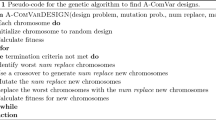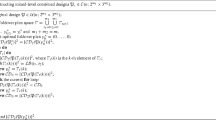Summary
This paper offers plans mainly for 2m factorial fractions with (6“E m”ElO), each of which possesses the following properties: (i) the general mean and all the main effects and two factor interactions are estimable, assuming the higher order interactions to be zero; (ii) the number of assemblies involved is kept at a minimum, with the condition that the available number of degrees of freedom for error is not too few; (iii) the fraction is subdivided into blocks (size 8 for 6“Em”E7, size 16 for 8“Em”ElO); (iv) the estimates of the main effects and interactions can be obtained without any special adjustment needed for eliminating the block effects; (v) structurally, the fraction possesses a partial balance; and (vi) subject to the above conditions, the fraction has been chosen so that for any pair of effects, the correlations between the corresponding estimates may not be too large. (In each fraction, the general mean has zero correlation with the other effects.) Furthermore, the inverses of the matrices involved in the normal equations have also been presented so that a complete analysis is available for each fraction.
Also for high-precision experiments where the error variance is very low, but the cost of observation per assembly is very high, a whole series of2 m fractions has been presented. These fractions may also be useful for situations where a good estimate of error variance is available from past experience. Each of these fractions possesses the property (i) above. Furthermore the fraction requires only a minimum ofv assemblies, wherev is the number of effects to be estimated. To this an optional m + 1 assemblies could be added for the estimation of error, by including a dummy factor.
Similar content being viewed by others
References
S. Addelman, “Irregular fractions of the 2n factorial experiments,”Technometrics, 3 (1961), 479–496.
R. C. Bose, “Mathematical theory of the symmetrical factorial design,”Sankhyā,8 (1947), 107–166.
R. C. Bose and J. N. Srivastava, “Mathematical theory of the factorial designs, I. Analysis, II. Construction,”Bull. Int. Slat. Inst., 40 (26) (1963), 780–794.
R. C. Bose and J. N. Srivastava, “Analysis of irregular factorial fractions,”Sankhyā, 26 (1964), 117–144.
R. C. Bose and J. N. Srivastava, “Multidimensional partially balanced designs and their analysis with application to partially balanced factorial fractions,”Sankhyā, 26 (1964), 145–168.
R. C. Bose and J. N. Srivastava, “On certain bounds useful in the theory of factorial experiments and error-correcting codes,”Ann. Math. Statist., 35 (1964), 408–414.
G. E. P. Box and J. S. Hunter, “The 2k-p fractional factorial designs, Parts I and II,”Technometrics, 3 (1961), 311–351, 449–458.
C. Daniel, “Sequential fractional replicates in the2 p-q series,”Jour. Amer. Stat. Assoc., 57 (1962), 403–429.
D. J. Finney, “The fractional replication of factorial experiments,”Annals of Eugenics, 12 (1945), 291–301.
O. Kempthorne, “A simple approach to confounding and fractional replication in factorial experiments,”Biometrika, 34 (1947), 255–272.
[11]O. Kempthorne,The Design and Analysis of Experiments, John Wiley, New York, 1952.
[12]K. Kishen, “On fractional replication of the general symmetrical factorial design,”Jour. ind. Soc. Agr. Stat., 1 (1948), 91–106.
K. Kishen and J. N. Srivastava, “Mathematical theory of confounding in symmetrical and asymmetrical factorial experiments,”Jour. Ind. Soc. Agr. Stat., 11 (1960), 73–110.
M. S. Patel, “Investigations in factorial designs,” Ph. D. Thesis, Univ. of North Carolina, Department of Statistics, 1961.
R. L. Plackett and J. P. Burman, “The design of optimum multifactorial experiments,”Biometrika, 33 (1946), 305–325.
C. R. Rao, “The theory of fractional replication in factorial experiments,”Sankhyā, 10 (1950), 81–86.
J. N. Srivastava, “Contributions to the construction and analysis of designs,”Univ. of North Carolina, Institute of Statistics, Mimeo Series No. 301 (1961).
J. N. Srivastava and R. C. Bose, “Economic partially balanced 2n factorial fractions,” Abstract,Ann. Math. Statist., 34 (1963), 1622.
J. C. Whitwell and G. K. Morbey, “Reduced designs of resolution five,”Technometrics, 3 (1961), 459–477.
F. Yates, “The design and analysis of factorial experiments,”Imperial Bureau of Soil Science, Technical Communication No. 35 (1937).
Author information
Authors and Affiliations
About this article
Cite this article
Srivastava, J.N., Bose, R.C. Some economic partially balanced 2m factorial fractions. Ann Inst Stat Math 18, 57–73 (1966). https://doi.org/10.1007/BF02869517
Received:
Issue Date:
DOI: https://doi.org/10.1007/BF02869517




